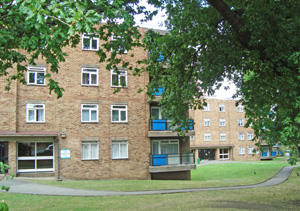|
Clock and Watchmakers Almshouses Waterfall Road, New Southgate, N11 1LH
|
While charities existed already for the employers of the clock and watch makers trade and for its working men, it was hoped that an institution could be established to enable both parties to meet on neutral ground. To this end, in 1853 a meeting was held in Clerkenwell, then the centre of the trade. It was presided over by the MP for Clerkenwell and Lord Mayor of London, Thomas Challis.
Following this meeting, the institution was established the same year. It would be known as the Clock and Watchmakers Asylum, a charity which would provide almshouses and pensions for aged and infirm members of the trade and their widows. Fund-raising began and, in January 1854, as he lay on this death bed, even the clockmaker to the Crown, Benjamin Lewis Vulliamy, was approached by a delegation of the trade to discuss the building of almshouses.
However, it was not until 1857 that the foundation stone was laid for the Asylum, A piece of land had been purchased for £700 in a "delightful spot" to the east of Colney Hatch & Southgate station (now New Southgate), served by the Great Northern Railway. Preparation of the site for drainage, etc. had cost an additional £100.
The buildings were of red brick with stone dressings, built in the Tudor style, at a cost of £2,500. It was planned to add two wings later but, at this stage, funds for maintenance had not yet been established.
Those eligible for admission to the Asylum were poor elderly members of the clock and watchmakers trades, regardless of religion, gender or race. No married couple was admitted unless the husband had worked in the trade for 25 years, and no widow unless her late husband had worked for 20 years.
As well as a rent-free home, the almspeople received light, coals and, when needed, medical attendance. Men received an annual stipend of £20, while widows received £13.
In 1864 William Rowlands, a Master of the Clockmakers Company, gifted the Company a £1,000 bond, the interest of which was to be donated to the inmates of the Asylum. Thereafter, each year on 25th August - Founders' Day - each pensioner would receive 20 shillings (£1), unless he had been a Freeman of the Company, in which case he (or his widow) would receive 30 shillings (£1.50); a Liveryman (or his widow) would receive 40 shillings (£2). Also on the same day the friends of the institution and its inmates were treated to a "handsome entertainment" in the grounds of the Asylum.
In 1875 the Asylum was extended, when a new building - the Workmen's Memorial Home - opened. It had been erected by the Goldsmiths Company.
By 1884 more almshouses had been added, one financed by the workmen of the trade and two by the private benevolence of individuals. The Asylum then consisted of 21 dwellings, accommodating 18 married couples and three widows. The £20 annual stipend to men had increased to £24 and to widows £15 following an appeal to the Goldsmiths Company and the Clockmakers Company, who increased their annual grants to the Asylum - to £90 by the former and £30 by the latter.
In 1884 an Appeal was launched to defray the costs of alterations to the Board Room and the Warden's apartment. It had been necessary to enlarge the Board Room so that the almspeople could be accommodated for religious services and social meetings. The trustees also wished to build three more almshouses for widows, so that the proportion of male and female inmates was maintained according to the rules.
On 14th November 1903 the foundation stone was laid by Mrs Meek for the P.J. Meek Nurses House.
In 1915 a meeting was held to effect the amalgamation of the Asylum with the Watch and Clock Makers Benevolent Institution and the Watch and Clock Makers Pension Society. This became the National Benevolent Society of Watch and Clock Makers, which took over control of the Asylum.
In 1925 the trustees applied successfully for royal patronage.
In the early 1930s the Asylum was renamed The Homestead (the term 'Asylum' had fallen out of favour in the 1920s).
Current status
The almshouses were demolished in the mid 1960s. Their site was redeveloped by Barnet Council. It is now occupied by three large apartment blocks and a driveway - all still called The Homestead.N.B. Photographs obtained in August 2012

The Homestead contains 63 dwellings (above and below).


The driveway, off Waterfall Road, is also called The Homestead.
References (Accessed 18th June 2021)
Atkins SE, Overall WH 1881Some Account of the Worshipful Company of Clockmakers of the City of London. Self-published. 223-225.
(Author unstated) 1875 Clock and Watch Makers' Asylum. Watchmaker, Jeweller and Silversmith 1 (6) 135.
Maguire R 1884 Words to watchmakers. Watchmaker, Jeweller and Silversmith 9 (104), 95-96.
https://aim25.com
https://commons.wikipedia.org
https://issuu.com
https://search.lma.gov.uk
https://wellcomecollection.org
www.friern-barnet.com (1)
www.friern-barnet.com (2)
www.friern-barnet.com (3)
www.hertsmemories.org.uk
www.londonpicturearchive.org.uk
www.lookandlearn.com
www.mutualart.com
Last updated 18th June 2021
Click here to return to Almshouses of London alphabetical list
Click here to return to home page